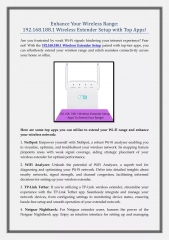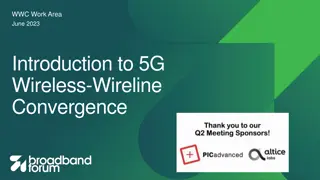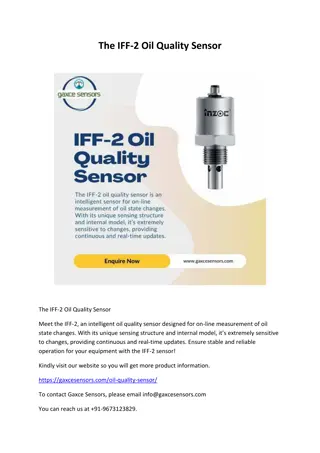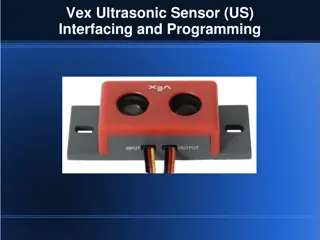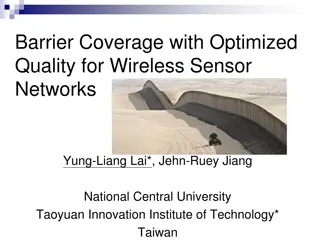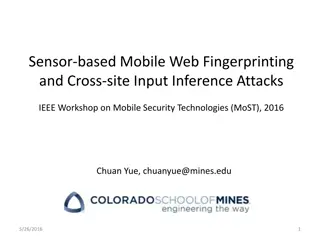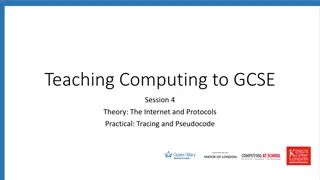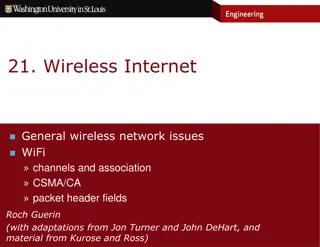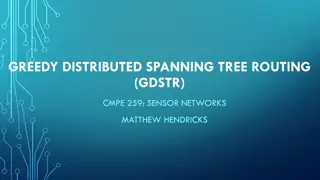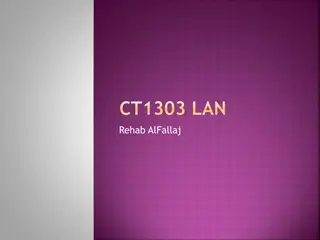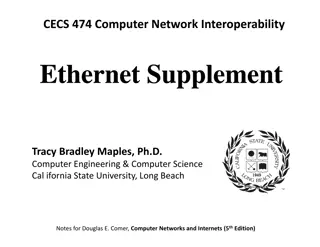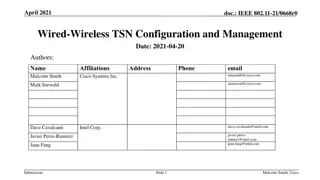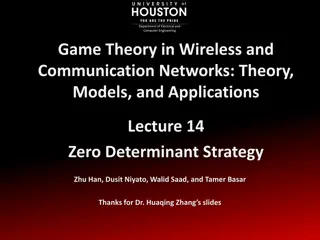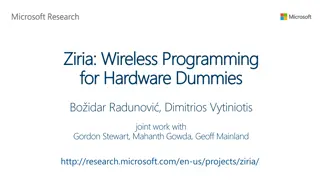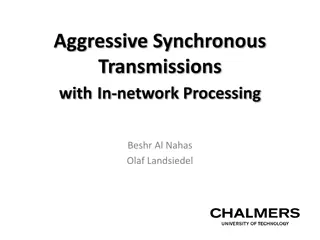Wireless Sensor Networks: Medium Access Protocols Overview
This collection of images presents key concepts in wireless sensor networks, focusing on medium access protocols, the ISO/OSI reference model, types of conflict resolution, contention-free protocols, Bitmap protocol, ALOHA algorithm, and its analysis and efficiency. Various protocols and algorithms like TDMA, FDMA, CDMA, Token Bus, and ALOHA are discussed, highlighting their advantages and disadvantages in the context of data transmission in wireless networks.
Download Presentation

Please find below an Image/Link to download the presentation.
The content on the website is provided AS IS for your information and personal use only. It may not be sold, licensed, or shared on other websites without obtaining consent from the author. Download presentation by click this link. If you encounter any issues during the download, it is possible that the publisher has removed the file from their server.
E N D
Presentation Transcript
Wireless Sensor Networks 4. Medium Access Christian Schindelhauer Technische Fakult t Rechnernetze und Telematik Albert-Ludwigs-Universit t Freiburg Version 29.04.2016 1
ISO/OSI Reference model 7. Application - Data transmission, e-mail, terminal, remote login 6. Presentation - System-dependent presentation of the data (EBCDIC / ASCII) 5. Session - start, end, restart 4. Transport - Segmentation, congestion 3. Network - Routing 2. Data Link - Checksums, flow control 1. Physical - Mechanics, electrics 2
Types of Conflict Resolution Conflict-free - TDMA, Bitmap - FDMA, CDMA, Token Bus Contention-based - Pure contention - Restricted contention Other solutions - z.B. MAC for directed antennae 3
Contention Free Protocols Simple Example: Static Time Division Multiple Access (TDMA) - Each station is assigned a fixed time slot in a repeating time schedule - Traffic-Bursts cause waste of bandwidth 4
Bitmap Protokoll Problems of TDMA - If a station has nothing to send, then the channel is not used Reservation system: bitmap protocol - Static short reservation slots for the announcement - Must be received by each station Problem - Set of participants must be fixed and known a-priori - because of the allocation of contention slots 5
ALOHA Algorithm - Once a paket is present, it will be sent Origin - 1985 by Abrahmson et al., University of Hawaii - For use in satellite connections 6
ALOHA Analysis Advantage - simple - no coordination necessary Disadvantage - collisions sender does not check the channel - sender does not know whether the transmission will be successful ACKs are necessary ACKs can also collide 8
ALOHA Efficiency Consider Poisson-process for generation of packets - describe infinitely many stations with similar behavior - time between two transmission is exponentially distributed - let G be the expectation of the transmission per packet length - all packets have equal length - Then we have For a successful transmission, no collision with another packet may happen - How probable is a successful transmission? 9
ALOHA Efficiency A packet X is disturbed if - a packet starts just before X - a packet starts shortly after X starts A packet is successfully transmitted, - if during an interval of two packets no other packets are transmitted 10
Slotted ALOHA ALOHA s problem - long vulnerability of a packet Reduction through use slots - synchronization is assumed Result - vulnerability is halved - throughput is doubled S(G) = Ge-G optimal for G=1, S=1/e 12
Slotted ALOHA Effizienz A packet X is disturbed if - a package starts just before X The packet is successfully transmitted, - when transmitting over a period of one packets no (other) packets appears 13
Throughput with respect to the Load (Slotted) ALOHA not a good protocol - Throughput breaks down for increasing demand S 1 Optimal 1 G 14
CSMA und Transmission Time B CSMA-Problem: - Transmission delay d Two stations - start sending at times t and t + with <d - see a free channel 2nd Station - causes a collision A t t+ 16
Collision Detection in Ethernet CSMA/CD B A CSMA/CD Carrier Sense Multiple Access/Collision Detection - Ethernet If collision detection during reception is possible - Both senders interrupt sending - Waste of time is reduced Collision Detection - simultaneously listening and sending must be possible - Is that what happens on the channel that's identical to the message? t+ 17
Computation of the Backoff Algorithm: Binary Exponential Backoff - k:=2 - While a collision has occurred choose t randomly uniformly from {0,...,k-1} wait t time units send message (terminate in case of collision) k:= 2 k Algorithm - waiting time adapts to the number of stations - uniform utilization of the channel - fair in the long term 19
Problem of Wireless Media Access Unknown number of participants - broadcast - many nodes simultaneously - only one channel available - asymmetric situations Collisions produce interference Media Access - Rules to participate in a network 20
Aims Delay Throughput Fairness Robustness and stability - against disturbances on the channel - against mobility Scalability Energy efficiency 21
Methods Organisation - Central control - Distributed control Access - without contention - with contention 22
Problem of Media Access CSMA/CD not applicable - Media is only locally known - Bounded range Hidden Terminal - Receiver collision despite carrier sensing Exposed Terminal - Opportunity costs of unsent messages because of carrier sensing 23
Hidden Terminal and Exposed Terminal Hidden Terminal Problem A B C Exposed Terminal Problem A B C D 24
Alternative Solutions Extended hardware - Addition carrier signal blocks and ensures transmission Centralized solution - Base station is the only communication partner - Base station coordinates the media access 25
MACA Phil Karn - MACA: A New Channel Access Method for Packet Radio 1990 Alternative names: - Carrier Sensing Multiple Access / Collision Avoidance (CSMA/CA) - Medium Access with Collision Avoidance (MACA) Aim - Solution of the Hidden and Exposed Terminal Problem Idea - Channel reservation before the communication - Minimization of collision cost 26
Request to Send (a) A sends Request to Send (RTS) (b) B answers with Clear to Send (CTS) 27
Clear to Send (a) A sends Request to Send (RTS) (b) B answers with Clear to Send (CTS) 28
Details for Sender A sends RTS - waits certain time for CTS If A receives CTS in time - A sends packet - otherwise A assumes a collision at B doubles Backoff-counter and chooses a random waiting time from {1,...,Backoff } - After the waiting time A repeats from the beginning 30
Details for Receiver After B has received RTS - B sends CTS - B waits some time for the data packet - If the data packet arrives then the process is finished Otherwise B is not blocked 31
Details for Third Parties C receives RTS of A - waits certain time for CTS of B If CTS does not occur - C is free for own communication If CTS of B has been received - then C waits long enough such that B can receive the data packet 32
Details for Third Parties D receives CTS of B - waits long enough such that B can receive the data packet E receives RTS of A and CTS of B - waits long enough such that B can receive the data packet 33
MACAW Bharghavan, Demers, Shenker, Zhang - MACAW: A Media Access Protocol for Wireless LAN s, SIGCOMM 1994 - Palo Alto Research Center, Xerox Aim - Redesign of MACA - Improved backoff - Fairer bandwidth sharing using Streams - Higher efficiency by 4- and 5-Handshake 34
Acknowledgment in the Data Link Layer MACA - does not use Acks - initiated by Transport Layer - very inefficient How can MACA use Acks? 35
MACAW 4 Handshake Participants - Sender sends RTS - Receiver answers with CTS - Sender sends data packet - Receiver acknowledges (ACK) Third parties - Nodes receiving RTS or CTS are blocked for some time - RTS and CTS describe the transmission duration Sender repeats RTS, if no ACK has been received - If receiver has sent ACK - then the receiver sends (instead of CTS) another ACK 36
MACA 4-Handshake RTS 38
MACAW 4-Handshake CTS 39
MACAW 4-Handshake Data 40
MACAW 4-Handshake Ack 41
Acknowledgments Adding ACKs to MACA - In MACA done by transport layer leads to drastical improvements of throughput even for moderate error rates throughput error rate RTS-CTS- DATA 40 RTS-CTS- DATA-ACK 37 0 0,001 37 37 0,01 17 36 0,1 2 10 42
MACAW 4 Handshake Worst-Case blockade - Sender sends RTS - Receiver is blocked - Sender is free - But the environment of the sender is blocked 43
MACAW 4-Handshake RTS 44
MACAW 4-Handshake CTS is missing 45
MACAW 5 Handshake 4-Handshake increases Exposed Terminal Problem - Overheard RTS blocks nodes - even if there is no data transfer Solution - Exposed Terminals are informed whether data transmission occurs - Short message DS (data send) 5 Handshake reduces waiting time for exposed terminals 46
MACAW 5 Handshake Participants - Sender sends RTS - Receivers answers with CTS - Sender sends DS (Data Send) - Sender sends DATA PACKET - Receiver acknowledges (ACK) RTS and CTS announce the transmission duration Blocked nodes - have received RTS and DS - have received CTS Small effort decreases the number of exposed terminals 47
MACAW 5-Handshake RTS 48
MACAW 5-Handshake CTS 49
MACAW 5-Handshake DS 50


